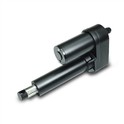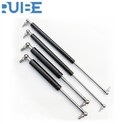As a supplier of Gas Spring for Chair, I've witnessed firsthand the importance of these components in ensuring the comfort and functionality of chairs. However, like any mechanical part, gas springs are prone to failure over time. Understanding the factors that contribute to gas spring failure is crucial for both manufacturers and end-users. In this blog post, I'll delve into the various causes of gas spring failure in chairs, providing insights that can help you make informed decisions and extend the lifespan of your products.
Quality of Materials
One of the primary factors influencing the durability of a gas spring is the quality of materials used in its construction. Gas springs consist of several key components, including the cylinder, piston, rod, and seals. Each of these parts must be made from high-quality materials to withstand the forces and pressures exerted during normal use.


- Cylinder and Piston: The cylinder and piston are typically made from steel or aluminum. Low-quality metals may contain impurities or have inconsistent thickness, which can lead to corrosion, wear, and deformation over time. Corrosion weakens the structure of the gas spring, increasing the risk of leaks and failure. Additionally, if the cylinder and piston are not precisely machined, it can cause uneven movement and premature wear.
- Rod: The rod is another critical component that must be made from high-strength materials. A rod that is too thin or made from inferior steel may bend or break under heavy loads, rendering the gas spring useless. Moreover, the surface finish of the rod is important to prevent damage to the seals and ensure smooth operation.
- Seals: Seals play a vital role in preventing gas leakage and maintaining the pressure inside the gas spring. Low-quality seals may not provide a tight fit, allowing gas to escape and reducing the spring's performance. Over time, seals can also deteriorate due to exposure to heat, chemicals, and wear, leading to leaks and failure.
When sourcing gas springs for chairs, it's essential to choose a supplier that uses high-quality materials and adheres to strict manufacturing standards. At our company, we only use premium-grade materials and state-of-the-art manufacturing processes to ensure the reliability and durability of our Gas Spring for Chair.
Overloading
Another common cause of gas spring failure is overloading. Gas springs are designed to support a specific weight range, and exceeding this limit can put excessive stress on the components, leading to premature wear and failure.
- Excessive Weight: Chairs are often used by people of different sizes and weights, and it's important to choose a gas spring that can handle the maximum load. If a gas spring is rated for a lower weight than the actual user, it may compress too quickly or fail to support the chair properly. This can cause the chair to sink or become unstable, posing a safety hazard.
- Dynamic Loads: In addition to static weight, chairs are also subjected to dynamic loads, such as sudden movements, impacts, and vibrations. These loads can be much higher than the static weight and can cause significant stress on the gas spring. For example, if a person jumps or sits down forcefully on a chair, it can put a sudden shock on the gas spring, potentially damaging the seals or the rod.
To prevent overloading, it's important to select a gas spring with a suitable weight rating for the intended use. Our Gas Spring for Office Chair is available in a range of weight capacities to ensure that you can find the right one for your specific application.
Environmental Factors
The environment in which a chair is used can also have a significant impact on the performance and lifespan of the gas spring. Exposure to extreme temperatures, humidity, chemicals, and dust can all contribute to gas spring failure.
- Temperature: Gas springs are sensitive to temperature changes, and extreme heat or cold can affect their performance. In high temperatures, the gas inside the spring expands, increasing the pressure and potentially causing leaks. Conversely, in cold temperatures, the gas contracts, reducing the spring's stiffness and making it less effective.
- Humidity: High humidity levels can cause corrosion and rust on the metal components of the gas spring, weakening the structure and increasing the risk of failure. Moisture can also seep into the seals, causing them to swell and lose their effectiveness.
- Chemicals: Exposure to chemicals, such as cleaning agents, solvents, and lubricants, can damage the seals and other components of the gas spring. Some chemicals may react with the materials used in the spring, causing corrosion, degradation, or swelling.
- Dust and Debris: Dust and debris can accumulate inside the gas spring, causing abrasion and wear on the moving parts. This can lead to increased friction, reduced performance, and premature failure.
To minimize the impact of environmental factors, it's important to choose a gas spring that is designed for the specific environment in which it will be used. Our gas springs are treated with special coatings and finishes to provide protection against corrosion, moisture, and chemicals. Additionally, we recommend regular cleaning and maintenance to keep the gas spring in good condition.
Improper Installation
Improper installation is another common cause of gas spring failure. If a gas spring is not installed correctly, it can put additional stress on the components, leading to premature wear and failure.
- Incorrect Mounting: Gas springs must be mounted correctly to ensure proper alignment and operation. If the spring is mounted at an angle or in the wrong position, it can cause uneven movement and excessive stress on the rod and seals. This can lead to premature wear and failure.
- Loose or Tight Connections: The connections between the gas spring and the chair frame must be secure and tight. Loose connections can cause the spring to move or vibrate, leading to increased wear and potential failure. On the other hand, overly tight connections can damage the components and prevent the spring from functioning properly.
- Lack of Lubrication: Some gas springs require lubrication to ensure smooth operation. If the spring is not lubricated correctly or at the recommended intervals, it can cause increased friction and wear on the moving parts. This can lead to reduced performance and premature failure.
To ensure proper installation, it's important to follow the manufacturer's instructions carefully. Our company provides detailed installation guides and support to help our customers install our Gas Spring for Chair correctly.
Wear and Tear
Over time, normal wear and tear can also cause gas spring failure. As the gas spring is used, the components will gradually wear down, reducing their performance and lifespan.
- Friction: The moving parts of the gas spring, such as the rod and piston, are subject to friction during operation. Over time, this friction can cause wear on the surfaces, leading to increased clearance and reduced performance. Eventually, the wear may become so severe that the gas spring fails.
- Fatigue: Gas springs are designed to withstand a certain number of cycles of compression and extension. Over time, the repeated stress can cause fatigue in the materials, leading to cracks and fractures. Fatigue failure is more likely to occur in gas springs that are subjected to high loads or frequent use.
- Seal Degradation: As mentioned earlier, the seals are an important component of the gas spring, and they can degrade over time due to wear, heat, and chemicals. Once the seals start to leak, the gas spring will lose its effectiveness and may eventually fail.
To extend the lifespan of your gas springs, it's important to perform regular maintenance and inspections. This includes checking for signs of wear, lubricating the moving parts, and replacing any worn or damaged components. Our company offers a range of maintenance and repair services to help our customers keep their gas springs in good condition.
Conclusion
In conclusion, there are several factors that can cause a gas spring for a chair to fail, including the quality of materials, overloading, environmental factors, improper installation, and wear and tear. By understanding these causes and taking appropriate measures to prevent them, you can extend the lifespan of your gas springs and ensure the comfort and safety of your chairs.
As a leading supplier of Gas Spring for Chair, we are committed to providing our customers with high-quality products and excellent service. If you have any questions or need assistance with choosing the right gas spring for your application, please don't hesitate to contact us. We look forward to working with you to meet your gas spring needs.
References
- "Gas Springs: Design, Selection, and Application" by Bill Hicks
- "Mechanical Design Handbook" by Robert C. Juvinall and Kurt M. Marshek
- "Engineering Materials and Their Applications" by Lawrence F. Coffin, Jr. and George S. Vander Voort






